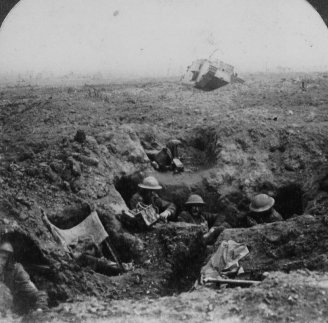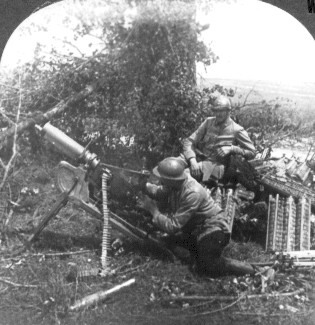Trench Warfare
Today, let's go to war. The University of Houston's College of Engineering presents this series about the machines that make our civilization run, and the people whose ingenuity created them.
Barbara Tuchman's book about WW-I is called The Guns of August, because the form of the war was set during its first few days in August of 1914. The German attack plan, out of a 19th-century military strategy book, promised victory in a few weeks. Yet the war quickly turned into four years of human attrition along a double line of trenches that ran from Nancy west to near Paris, and then north to Ostend. By the time the carnage was over, 8½ million men had died -- most of them on this 350-mile line.
The generals on both sides tried to fight the war the way Napoleon would have. They had plenty of warnings that the new technologies of slaughter would create a stalemate. But the warnings were misread.
Napoleonic muskets had evolved into rapid-firing rifles -- like the British Enfield. The machine gun had matured. These weapons laid down a field of fire that made open-field attacks impossible. But, once troops were entrenched, they were practically immovable. The Civil War had already made it pretty clear that even the first breech-loading rifles were going to make a mess of traditional warfare.
European generals weren't about to use America as a military textbook, but they really should have paid more attention to their own Battle of Duppel in 1862. 6000 ill-equipped Danes built a 3000-foot continuous fortified trench and held off 18,000 well-equipped Prussians. The Prussians went at the Danes the way you're supposed to go after troops in a conventional masonry fort. Instead of crumbling under artillery fire, the protective dirt just flew into the air and fell back down. The Prussians did finally overrun the Danes, but it took them two months and far too many lives. Instead of seeing that the Danish trench was a remarkable new defensive strategy, the Prussians simply figured that conventional tactics had taken a little longer than they should have.
Storm warnings like this kept coming. Open-field formations were cut to pieces in the Prussian-Austrian conflict in 1866, and again when the Russians fought the Turks in 1877.
So WW-I settled into a double row of trenches. 5000 men were killed in a slack week. A half-million were lost in a pitched assault. But the line hardly moved. The stalemate was finally broken in 1918, when the Allies came out with a new weapon -- the armored tank -- and a set of tactics for using it.
We won the war; but 22 years later, Germany did much the same thing to the Allies. The French had developed a kind of super-trench called the Maginot line that didn't even slow down the German panzer-tank units. And so, in 1940, this terrible cycle of technology began its next round.
I'm John Lienhard, at the University of Houston, where we're interested in the way inventive minds work.
(Theme music)
Robinson, W. B., American Forts: Architectural Form and Function. Urbana, Ill.: University of Illinois Press. (Published for the Amon Carter Museum of Western Art, Fort Worth, TX), 1977.
Tuchman, B. W., The Guns of August. New York: Macmillan, 1962.
For more on this idea, see Episode 870.

(Image provided by Sims McCutchan)
Stereopticon photo of a WW-1 battlefield: trenches in the foreground and one of the earliest tanks ruined in the background. The tank would prevail.

(Image provided by Margaret Culbertson)
A typical WW-I machine gun